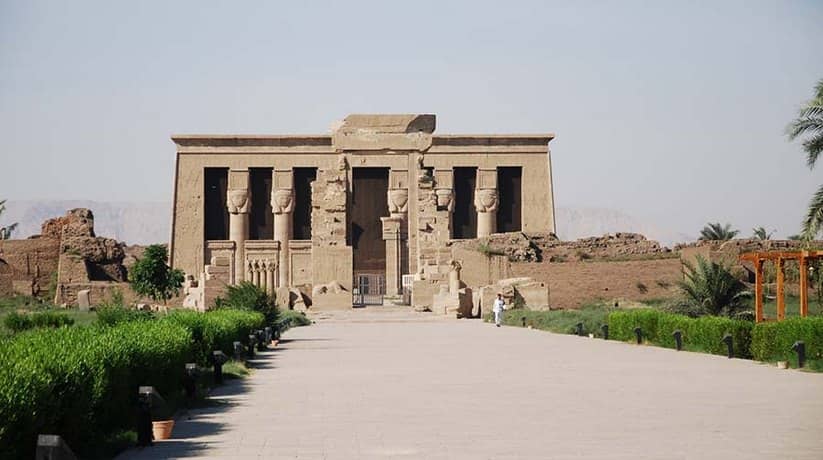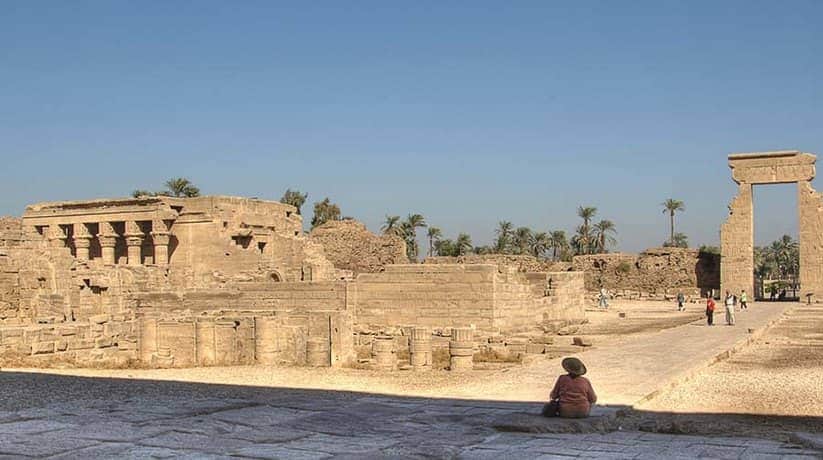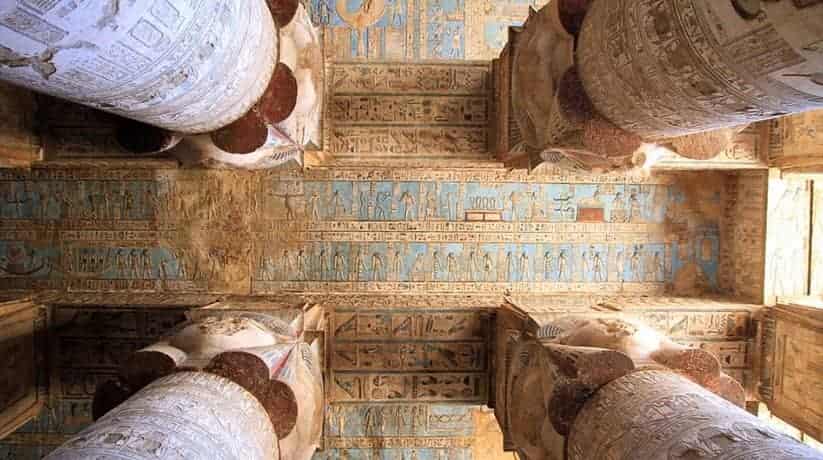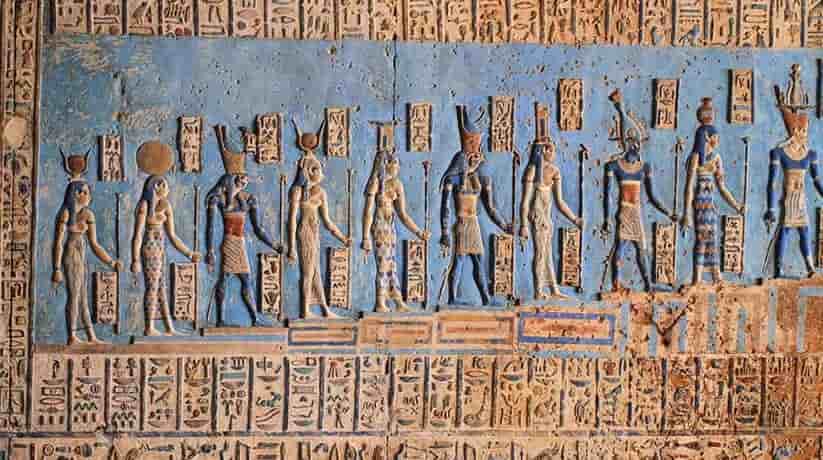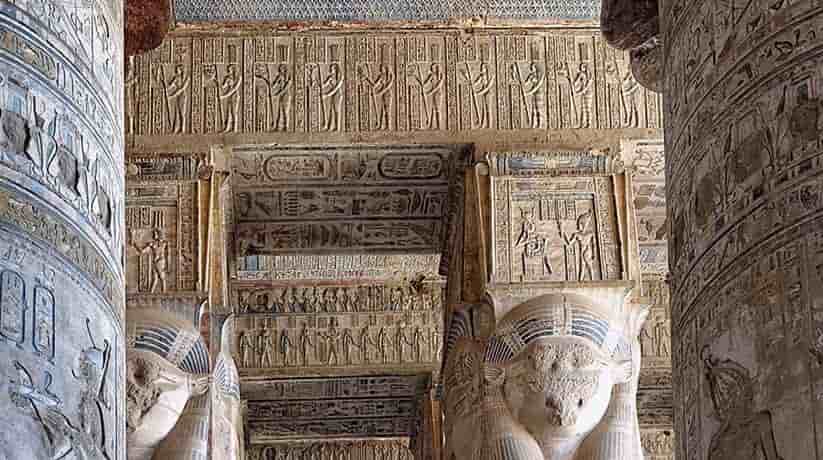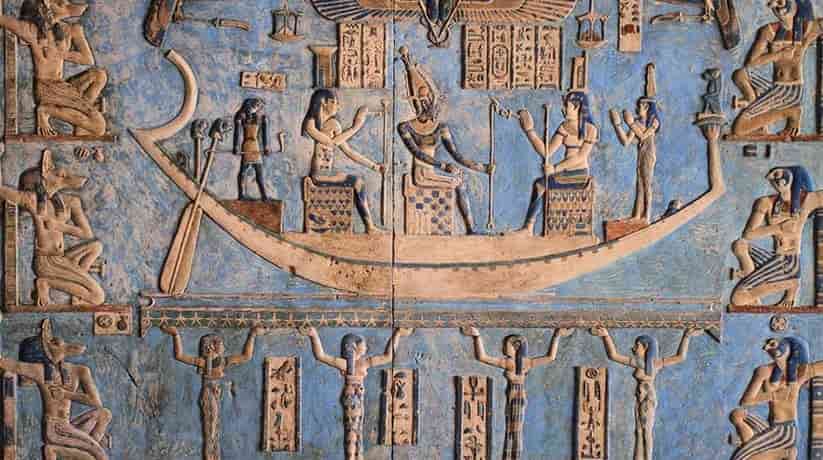Dendera temple Luxor Egypt tours, prices, booking, reviews
Dendera temple Luxor located about 60 kilometers north of Luxor. It is on the west bank of the Nile River and opposite the provincial modern. Along with Dendera temple itself, there is also a necropolis. The necropolis includes tombs of the Early Dynastic Period. The most important phase that has identified was the end of the Old Kingdom. It is besides to the 1st Intermediate Period. In fact, the provinces were autonomous at that time and. Dendera was not a leading political force in Upper Egypt. Its notables built many Mastabas of some size. Though only one has any decoration apart from stelae and false doors. Moreover, on the west end of Dendera temple site are brick which vaulted catacombs.
In fact, the catacombs are of Late Period animal burials, birds and dogs. It is while cow burials found at various points in the necropolis. Of course, this was a significant site for the Hathor cult, whose forms included a cow. Dendera temple complex oriented toward the Nile, which here flows east-west. The temple faces north. Dendera temple Luxor main area fronted by several Roman Period kiosks. Monumental gateway of Domitian and Trajan set in a massive mud-brick enclosure wall. It surrounded the complex, and leads to an open area. The site lacks a colonnade. Moreover, there are two pylons which ought to precede the inner temple.
Further details about Dendera temple Luxor:
An unfinished inner enclosure wall of stone surrounds a courtyard with side entrances. Moreover, it opens before the large hypo-style hall added in the 1st century AC by the emperor Tiberius. Dendera temple proper is the Roman Period birth house of Dendera on the west. It perhaps built by Nero, though more by Trajan. Although the dedication inscriptions refer to Trajan, Nero depicted. It is in the main hypo-style hall of the of the Hathor temple, offering the model of a birth house. In fact, it the latest preserved temple of its type. Furthermore, the new sanctuary well designed and followed Ptolemaic models. In fact, it was to match the level of the Hathor temple, the new building erected on a high platform. Furthermore, a temporary access staircase led up at the side of the platform.
In fact, the roofing slabs not positioned. They beneath the level of the cavetto molding around the buildings top. But would have hidden by a parapet wall. Moreover, the core building contains a sequence of three rooms. Two corridors that isolate the large sanctuary are notable. These passages are too narrow to use. They added for symbolic and optical effect. Furthermore, the rear wall of the sanctuary dominated by an enormous false door. It framed by a double cavetto molding on slender columns and topped by an uraeus frieze. A cult niche high up in the wall corresponds to the location of the statue niche. In fact, the statue niche is in the sanctuary of the main temple. In fact, Dendera temple Luxor scenes depict Trajan, Augustus’ later successor, making offerings to Hathor. They are among the finest to found in Egypt.
More details:
It was the ritual location where Hathor gave birth to the young Ihy or Harsomtus. They are two alternative youthful deities. Moreover, they stand for the youthful phase of creator gods in general. There are also figures of the god Bes and a patron of childbirth. It carved on the abaci above the column capitals. In fact, the reliefs on the exterior walls preserved. They portray the divine birth and childhood of the infant Horus. It is whose rites legitimize the divine descent of the king. The birth house surrounded by an ambulatory. The composite capitals of the columns carry high pillars with Bes figures. The frontal ambulatory extended by the addition of three columns. It is into a kind of kiosk, with the front corners which formed by L-shaped pillars. The kiosk had a timbered roof that somehow must connected to the stone structure of the birth house.
This merging of the ambulatory with a kiosk is a novelty. At older birth houses, a court attached as a separate structure. The Roman Birth House (mammisi) built when the earlier structure, begun by Nectanebo I. It decorated in the Ptolemaic Period. Moreover, it cut through by the foundation of the unfinished first court of the main temple of Hathor. Only a false door at the eastern exterior wall of the main Dendera temple. It reminds one of the original sanctuary. This birth house measured about 17 by 20 meters. Furthermore, it consisted of a triple shrine opening to a transverse hall. Moreover, it built mainly of brick but received an interior stone casing. Within this older structure, the walls of the wide hall depict the Ptolemaic kings. In fact, they offer to Hathor.
Further details about Dendera temple Luxor:
A scene on the north wall shows the creator god Khnum fashioning the child, Ihy. It is with Hekat the goddess of childbirth which seen in her image as a frog. In fact, both birth houses are now accessible and differ in plan and decoration. Between the new and old birth houses are the remains of a Christian basilica. In fact, they date back to the 5th century AC. It is indeed an excellent example representative of early Coptic church architecture. South of the earlier birth house is a mud-brick. This sanatorium is the only one of its type known in association with an ancient Egyptian temple. Here, visitors could bathe in the sacred waters or spend the night to have a healing dream of the goddess. It had benches around its sides where the sick rested while waiting for cures affected by the priests.
The water poured over magical texts on the statues. It caused it to become holy and to cure all sorts of diseases and illnesses. Moreover, basins used to collect the holy water can still seen at the western end. To the west of the sanatorium, a small chapel of Nebhepetre’ Mentuhotep. It dates back to the 11th Dynasty, recovered from the site and re-erected in the Cairo Museum. In fact, Dendera temple Luxor is the grandest and most decorated of its period. Moreover, it is also indeed one of the most important temple sites of Egypt. Dendera temple provides examples of a rich variety of later temple features. Moreover, it also one of the best preserved temples of this period. In fact, it is despite the destruction of the temples of Hathor’s consort Horus and their child Ihy. The child statue stood close by.
More details:
The massive foundations contain many blocks from the earlier structure it replaced. Early texts refer that Dendera temple rebuilt during the Old Kingdom and several New Kingdom monarchs. They include Thutmose III, Amenhotep III, Ramses II and III. In fact, fragments of earlier periods found on the site, but there have no earlier buildings unearthed. Pepi I and Thutmose III in particular recalled in the new temple’s inscriptions. The temple of Hathor constructed over a period of thirty-four years, between 54 and 20 BC. When Ptolemy XII died in 51 BC, the temple was still in its early stages. It was after four years of building activity, although it contained some underground crypts. In fact, It seems that the rest of the temple built during the twenty one year reign of his successor.
The successor was Queen Cleopatra VII. At the time of her death in 30 BC, the decoration work just begun. It was on the outer rear wall. In fact, Dendera temple Luxor plan is classical Egyptian. Moreover, it enclosed by a 35 by 59 meter wall standing 12.5 meters high. The facade of the hypo-style hall that fronts the main temple constructed as a low screen. It is with inter-columnar walls exposing the hall’s ceiling and the Hathor style sistrum capitals of its 24 columns. This part of the temple built under Tiberius between 34 and 35 AD. In fact, it is according to a dedication inscription on the cornice thickness above the entrance. The structure measures 26.03 by 43 meters and is 17.2 meters high. Moreover, it has an 8 meter long architrave and towering cavetto built from one course.
Further details about Dendera temple Luxor:
The massive volume of the corner tori cast heavy shadows and articulate the edges of the facade. A sistrum is an ancient Egyptian musical instrument associated with Hathor. Each column bears a four-sided capital. It occupies about one third of the column height. Moreover, it carved with the face of the cow-eared goddess. Every one of the faces vandalized in antiquity. Furthermore, the shafts decorated with scenes and their straight bases stand on flat plinths. The paint, which still preserved in the 19th century, dominated by the blue of Hathor’s wig. The ceiling of this hall retains much of its original color. It decorated as a complex and aligned symbolic chart of the heavens. Moreover, it also includes signs of the zodiac and images of the sky goddess Nut.
Nut swallows the sun disc each evening to give birth to it once again at dawn. The outer hypo-style hall decorated by emperors ranging from Augustus to Nero. At the center of the south outside wall was a relief of a sistrum. It gilded, both to show its importance and to evoke Hathor, the “gold of the gods”. Moreover, a doorway aligned to the central axis of Dendera temple Luxor. In fact, it leads from the large hypo-style hall into an inner hall with six Hathor columns. It known as the hall of appearances. It was here that the statue of the goddess “appeared” from her sanctuary for religious ceremonies and processions. The front wall of this hall was actually the facade of the original temple. Lighting within the hall provided through small and square apertures. The chamber has columns in two rows of three and also Hathor heads.
More details:
The bases and the lower parts of the drums made of granite, while the upper parts are of sandstone. There are scenes on the walls of this hall. In fact, they depict the king participating in the foundation ceremonies for the construction of the temple. Moreover, on either side doors open into three chambers. They used as preparation areas for various aspects of the daily ritual. For example, one room used as a laboratory for preparation of ointments. An opening through the outer eastern wall allowed offering goods to brought into this area. A parallel passage from one of the western chambers led to a well. The rear part of the Dendera temple built first in the early 1st century BC. Moreover, the earliest king named is Ptolemy XII Auletes. The cartouches are blank because of dynastic struggles in the mid 1st century.
This inner core included an offering hall, in which sacrifices dedicated. A “hall of the Ennead” where statues of other deities assembled. It is with Hathor before a procession began. These followed by a 5.7 by 11.22 meter barque shrine. It once enclosed the four barques of Hathor, Horus of Edfu, Harsomtus and Isis. They which not enclosed by wooden shrines. After this small chamber there is the sanctuary of the goddess herself. Moreover, it embellished by a splendid, temple-like facade topped by a cavetto. It is with an uraeus frieze. Inside the sanctuary of Dendera temple, an decorated wooden naos. It held the gilded, two meter high seated cult image of Hathor. The naos stood in a niche of the rear wall. It not known how the niche, three meters above the pavement, could reached.
Further details about Dendera temple Luxor:
To either side of the this inner sanctuary, the king depicted. He offers a copper mirror, one of Hathor’s sacred emblems to the goddess. About the central sanctuary on its sides and rear located eleven chapels. They dedicated to the other deities who associated with Hathor’s chief attributes. Within Dendera temple Luxor the most distinctive parts are indeed the fourteen crypts. Eleven of them decorated and far surpass those of other temples. The inclusion of accessed crypts in temples dates back to the 18th Dynasty. By the Late Period crypts included in the architectural design of most temples. These are suites of rooms on three stories. They set in the thickness of the outside wall. The beneath the floors of the chambers in the rear part of the temple.
The elongated, narrow chambers and passages arranged one above the other. It is with the lowermost laid deep within the temple foundations. Access gained through trapdoors in the pavement and behind hidden sliding wall blocks. Unlike other crypts, those at Dendera decorated in relief. The decorations in these chambers conforms to the temple’s axis. The most important reliefs, among which sistra are prominent, were on the axis itself. These rooms decorated before the roof blocks set. On the roof in the southwest corner is a kiosk. It is in which the ritual of the goddess’s union with the sun disk performed. It has four Hathor columns on each side. Sockets in its architraves suggest a barrel-shaped timber roof. It is with a double hull and segmented pediment.
More details about Dendera temple in Luxor:
Though for its purpose it must had roof windows to let in the sun’s rays. In the floor of the chapel one may also note the light well for the Horus chapel below. The ba of Hathor would have taken from its hiding place to the roof of the temple. It is for the significant New year’s festival which celebrated. It is where it spent the night before beholding the rising sun in a symbolic union with the solar disc. The staircase to the west of the offering hall used by the priests to ascend to the roof. It has ascending figures of the king and various priests. It with the shrine of the goddess carved on its right hand wall. These representations depict various aspects of the New Year’s festival.
The stairway to the east has corresponding scenes of descending figures. It used for the procession’s return. There is also a pair of parallel shrines on the roof’s eastern and western sides which dedicated to Osiris. They concealed in a kind of mezzanine floor. Both of these sanctuaries have open courts, surrounded by a cavetto. From the rear wall of the court, three doors lead into two succeeding chambers. In the inner of the two rooms, Isis and Nephthys shown mourning the death of Osiris. Osiris lies on his funerary bier waiting to resurrected by magical rituals. Isis is also depicted, impregnated with the seed of her son Horus as the myth unfolds.
Further details about Dendera temple in Luxor:
A corresponding suite on the eastern side of the roof depicts the lunar festival of Khoiakh. It is in which an “Osiris bed” filled with earth and grain seed as part of an important fertility rite. The walls of the first room show scenes of the burial goods of Osiris. It included his canopic jars. On the ceiling Nut shown with other astronomical figures. On the other half of the ceiling is a plaster copy of the famous “Dendera Zodiac”. It representing the cospic aspect of the Osiris mysteries. The original is now in the Louvre in Paris. The inner room depicts scenes from the Osiris myth. They are like to that of the western suite as well as reliefs of cosmic importance.
Dendera considered one of Osiris’ many tombs and the shrines, which have no link with Hathor. It used to celebrate his death and resurrection. His death maybe re-enacted. It is at the sacred lake to the west of the temple. The roof of the hypo-style hall reached by another flight of steps. It is with various gods which carved along its wall. This highest area of Dendera temple used in antiquity by pious pilgrims. Pious pilgrims who awaited signs and miracles from the goddess. There remain gaming boards carved into the stone blocks. They helped these faithful pass the time during their vigils.
More details about Dendera temple in Luxor:
On the rear outside wall of Dendera temple beneath the two lion-headed waterspouts. There are also three more on each of its side walls. Drained rainwater from the roof are scenes. They showing the massive figure of Cleopatra VII and her son by Julius Caesar, Caesarion. He became the great queen’s co-regent as Ptolemy XV. At the center of the wall is the large False Door. It is with a gigantic emblem of Hathor and diminished over the centuries by pilgrims who scraped at it. It is to get a little of the sacred stone at a point. The point is where they could come closest to Hathor herself. This is the location of the “hearing ear” shrine. It is which allowed the goddess to “hear” the prayers of common folk.
Immediately south of the Hathor temple is the temple of Isis. It known as the Iseum. It used foundation blocks from a destroyed Ptolemaic building and decorated under Augustus. The east gateway leads to this temple. It is almost unique in having a dual orientation with the outer rooms. The hypo-style hall facing east and the inner ones north toward the temple of Hathor. The central high relief in the sanctuary showed Isis giving birth. It has mutilated. Within the rear wall of the sanctuary a statue of Osiris (now destroyed). It supported by the arms of Isis and Nephthys. At the temple’s southwest corner, lies the compound’s sacred lake. It provided water for the priests’ ablutions. It has flights of stairs descending from each corner.
Further details:
It is stone-lined ceremonial basin. In fact, it the best preserved of its type in any Egyptian temple. Today, it is empty of water and tall trees grow within its walls. Next to the lake is a well with rock-cut steps. The steps lead down to give access to water for daily use in the temple. East of the temple was a part of the town. It which the temple texts mention as having a temple of Horus of Edfu in its midst. This may be the same as some remains of the Roman Period about 500 meters from the main enclosure. The triads of deities worshiped at Edfu and at Dendera were similar. They consist of Horus, Hathor (or Isis) and Ihy or Harsomtus. Hathor of Dendera and Horus of Edfu met at a sacred “marriage” ceremony. It was when she made a progress to the south.
How to Get to Dendera temple Luxor:
A few years ago Dendera temple closed to visitors. Its cafeteria and gift shops almost derelict. It is now once more a thriving tourist attraction which often incorporated into the itinerary of a Nile Cruise. The temple can reached by taxi or coach tour from Luxor. Tickets at the gate cost 55 Egyptian pound.

